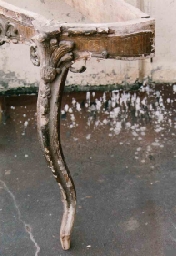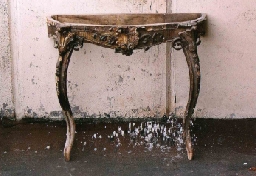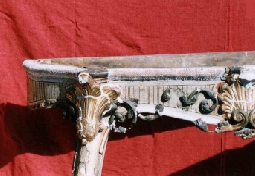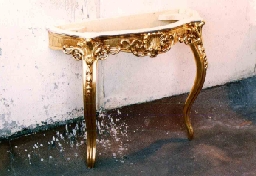|
|
|
|
|
| Panel
in the Stile of Rococo, End of 18th Century
|
| Introduction |
|
|
Dimensions:
|
|
| 60
cm in height, 90cm in width, 34 in length on a longest part |
|
| Final
facing: |
|
| Parcel
water silvered, parcel water gilded, parcel imitation of gilding |
|
| Type
of treatment: |
|
| Restoration |
|
| Storage
and display: |
|
| Private
collection, for everyday use |
|
|
|
|
|
|
Condition
This Object
was found left over in the old building cellar. Whole
surface was embedded with surface dirt.
Due to fact that the object spent long period of time
under the influence of increased humidity ornaments
made of traditional stucco cracked and parts of them
delaminated. On the end of the lags traditional gesso
completely delaminated under the influence of moisture.
Condition of wooden body was very good probable owing
to thick layer of ground applied on the all inside surfaces.
There was not any trace of fungi or pest contamination.
In constructional sense condition was also very good.
Construction was firm although cracks were present between
back and side rails joined by mortise and tenor. Small
corner block on the right was missing (fig.1. &
fig.2.).
Technical
Analysis
Prior to
restoration work the following analysis were performed:
Analysis
of Materials and Techniques Involved
The body
of the object was made of Beechwood (Fagus sp.). Ornaments
were made of traditional stucco supported with iron
armature which completely oxidized and lost quality.
Object surface was cowered with traditional gesso 2
to 3 mm thick, (calcium carbonate powder and organic
adhesive probable Fish-eye glue). Ornaments were covered
with layer of dark red bole then gilded and silvered
by water gilding technique (fig.3.). Other were decorated
with imitation of gilding probable using alloy foil
and oil size technique. Inside surfaces were treated
with traditional carpenters ground.
Identification
of Cowers on the All Parts of Object
The layer
of cower on the surface of object was the oily, dark
substance accumulated trough the time (fig.2.).
|
|
|
|
|
|
 |
|
|
 |
|
|
|
fig.1.
click on to zoom |
|
|
|
|
|
|
|
|
|
fig.2.
click on to zoom |
|
|
|
|
Choice
of Treatment
Treatment
on this object was performed in two phases:
Phase
I: Choice of Cleaning Treatment
Selection
of Solvents for Cower on the All Parts of Object
Test for
dissolution of cower was performed on the samples taken
from the surface of the object. Tested solvent was the
admixture of methylen chloride, methanol, cellulose
powder and paraffin oil with addition of tenzids.
Dissolved substance was rinsed with 96-99% ethyl alcohol.
After the process gesso, water gilding and silvering
on it stayed undamaged.
Cleaning
Process
Tested solvent
was gradually applied. After few minutes stimulated,
left to react for few minutes and stimulated again.
After 30 minutes dissolved substance was rinsed. On
some areas process was repeated due to very thick layer
of oil size and oil size ground.
Object was left for few ours to dray (fig.3.) and then
test with drop of water was performed to determine ability
of porous. Result of test was good so it was decided
not to repeat cleaning process.
|
|
|
|
 |
|
|
fig.3.
click on to zoom |
|
|
|
|
Phase
II: Choice of Restoration Treatments
Selection
of the Materials and Procedures for Crack Recovering
For recovery
of cracks in traditional stucco test was made with admixture
of powdered gypsum (CaSo4), kaolin and PVAC resin. Prior
to application of admixture crack was moistened with
15% etil alcohol to assure good contact of admixture
and wood. Solidification time was about 15 minutes.
Sample was left to dray for 12 hours. Test resulted
with solid, consolidation backfill.
Selection
of the Materials and Procedures for Consolidation and
Recovering of Original Gesso
Due to good
experience with admixture tested on cracks, it was tested
for filling of areas where the parts of original gesso
delaminated. Area was prepared with 15% ethyl alcohol
as the crack in previous test. Admixture was pushed
into and flattened with moistened spatula. The result
was satisfactory.
In order to consolidate the numerous small cracks in
original gesso, make better contact within original
gesso and new fill and make solid ground for new gesso
the 'contact ground' was tested. Request was to obtain
surface solid enough to resist pressure during the polishing
of gold and silver and porous to except new gesso. The
ground was composed of calcium carbonate, in form of
fine powder (Bologna chock), zinc oxide powder and PVAC
resin. By the and of mixing 90% izo propil alcohol was
added to improve leaving of captured air. To make it
applicable with brush admixture was diluted with distilled
water. Surface was coated 3 times with time delay of
15 minutes to provide solidification time for each layer.
Sample was left to dray for 12 hours. The result was
solid but porous surface, enough resistible on pressure
preventing the original gesso from delaminating.
Restoration
Process
Two curve
shaped corner blocks were mounted in the back corners
of construction. They were made of Pinewood (Pinus nigra)
and fixed with four 3 cm long screws and aliphatic resin
glue (1). Delaminated parts of ornaments made of traditional
stucco were affixed with help of admixture tested for
cracks. Missing parts of ornaments were made by sculpturing
and with help of shapers made of hard rubber used for
the reef elements along the legs and rails and for the
batten on the top of the rails. Before sculpturing new
armature made of protected copper was placed and fixed
with admixture tested for cracks. Support for reef elements
and batten was made by application of 3 cm long steel
nails along the reef and batten area. They were connected
with protected copper streak. Reef elements were made
in one pass. Batten was made in two passes, by application
of half of material, then burlap and then second half
of material to make it stronger and prevent from cracking
during the drying period (fig.4.). Some ornaments were
copied by the help of silicon mold.
Material used for sculpturing and coping was model plaster
(2) with addition of PVAC resin.
Drying period was 12 ours.
Tested admixture
was applied on cracks and flattened by moistened spatula.
Priors to application cracks were moistened with 15%
ethyl alcohol.
Delaminated pieces of gesso and carbonized substance
was removed mechanically. Previously tested procedure
was applied now. After 12 ours of drying areas of intervention
were shaped by the help of turbine.
Prior to application of the 'contact ground' whole surface
of object was cleaned whit 96% etil alcohol. The 'contact
ground' was applied in three layers as it was tested
and then it was left to dray for 2 hours. New traditional
gesso consists of technical whiting (CaCo3), zinc whiting
(ZnO2) and rabbit skin glue was applied shortly afterwards
in four layers. Every layer was left to solidificate
for 15 minutes. The ground and the new gesso was applied
only on surfaces planed for water gilding and silvering
and on surfaces where the procedure with admixture was
applied.
After 12 ours surfaces of object was shaped with sandpaper.
In order to prepare flat and smooth surface important
for quality of water gilding sanded surface was colored
with ocher bole and sanded again with 4 grades of sandpaper.
During the sending surface was rinsed with mineral spirit.
Next 12 ours object was left to dray.
Bole (3) mixed with 5% rabbit skin glue was partially
applied in 6 layers and then gilding and silvering was
performed by water gilding technique. After 12 our gilded
and silvered surfaces were burnished (fig.5.).
On the surfaces planed for imitation of gilding, prefabricated
nitro ground (4) was applied in 3 layers. After 30 minutes
of drying one coat of synthetic oil size (5) colored
with dark red neutral pigment (6) was applied. Imitation
was finished with Dutch metal leafs.
Toning was carried out with 'bitumen from Judea' (7)
mixed with turpentine and Damar lacquer.
Due to fact that this object will be exposed to the
circumstances of everyday use, final protection was
carried out with Zapon lacquer (8) thinned with acetone
(propanone). The inside area of the object was treated
with prefabricated carpenters ground (9) to prevent
it from possible cracking.
|
|
|
|
 |
|
 |
|
|
fig.4.
click on to zoom |
|
fig.5.
click on to zoom |
|
|
|
|
|
|
|
|
|
|
 |
|
|
|
|
fig.6.
click on to zoom |
|
|
|
|
| List
Of Used Prefabricated Materials
1. Aliphatic
resin glue: Titebond wood glue , Franklin International
, USA
2. Model plaster: Krone Hiliges Gipswerk, Germany
3. Bole: Red, Lefranc & Bourgeois France
4. Nitro ground: Duga, Yugoslavia
5. Synthetic oil size: Goldanlegeol - Mixtion, Lukas,
Germany
6. Dark red neutral pigment: Lefranc & Bourgeois
France
7. Bitumen from Judeja: Liberon , France
8. Zapon lacquer: Liberon , France
9. Carpenters ground: Duga, Yugoslavia
Applied
Gold, Silver and Metal Leafs
Gold leafs:
Orange Doppel Gold, 22 Karat, Noris, Germany
Silver leafs: Blattssilber Normal, Noris, Germany
Dutch metal: Noris, Germany
|
|
|
|
|
|
|
|
|
|